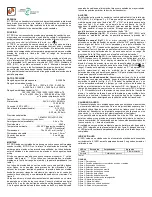
3-5
3.7.4
Front Panel Back Lighting
Front panel back lighting connection should be made on pin 3 of the transceiver. The
opposite end of this lead should be connected to the panel lighting system of the aircraft.
Before connecting, verify the required panel lighting voltage (28 VDC or 5VAC) on the
transceiver configuration control label.
3.7.5
Audio Outputs (600 ohms and 4 0hms)
The audio output from pin 9 can be used to drive a 4 ohm speaker up to 2.5 watts. Audio
output from pin 1 is 600 ohms, 0.5 watts maximum.
3.7.6
Audio Output Ground
Pin 10 is the ground for both the 4 ohm and 600 ohm audio output signals on pins 9 and 1.
3.7.7
Mic Signal Input
The microphone input signal is to be provided on pin 6, utilizing shielded wire with the shield
grounded to pin 10.
3.7.8
Memory Up/Memory Down
Remote scrolling through the 100 memory positions can be achieved by providing a ground
to
pins 4 (up) and 5 (down) through a momentary contact cyclic switch.
3.7.9
Data Input
Data communications equipment requiring direct access to the modulator and discriminator
can be connected via pins 2 and 11. Data cannot be transmitted in CANADA unless
equipment is approved for use with the TFM-138 unit by the communications regulatory
authority.
3.8
INTERNAL ENABLE/DISABLE JUMPER
The programming and direct frequency entry modes can be disabled by removing the
internal enable/disable jumper. Removal of this jumper will prevent operation on any
frequencies other than those programmed in the 100 memory positions and two guard
receiver memory positions.
The transceiver is always shipped with this jumper in the entry enable position. To place the
jumper in the disable position:
1.
Remove and retain the seven (7) No. 4-40 screws securing the bottom cover of the
transceiver to its chassis.
2.
Remove and retain the four (4) No. 4-40 screws securing the guard receiver PCB
module in the chassis tray. Remove the guard receiver module from the chassis tray.
3.
Remove and retain the two (2) screws securing the fuse board. Remove and retain
the five (5) screws securing the chassis tray to the main chassis. Remove the
chassis tray.
4.
You should now have access to the Microprocessor Control Unit (MCU) PCB Module
(See Figure 3-3). Remove the enable/disable jumper from pins 3 and 4 of J15.
5.
Reverse steps 1 through 3 and secure all screws to re-assemble the transceiver.
Содержание TFM-138
Страница 13: ...2 2 FIGURE 2 1 Operator s Switches and Controls TFM 138 F10 B software...
Страница 24: ...3 2 FIGURE 3 1 Outline Drawing for Model TFM 138 Transceiver...
Страница 26: ...3 4 Figure 3 2 Wiring Connections for TFM 138 Transceiver...
Страница 30: ...3 8 FIGURE 3 4 Microphone and Sidetone Level Main and Guard Squelch Adjustment Access Holes...
Страница 42: ...STEP SYSTEM PASS FAIL NOTES A 11...
Страница 43: ...STEP SYSTEM PASS FAIL NOTES A 12...
Страница 44: ...STEP SYSTEM PASS FAIL NOTES A 13 NOTES...
















































